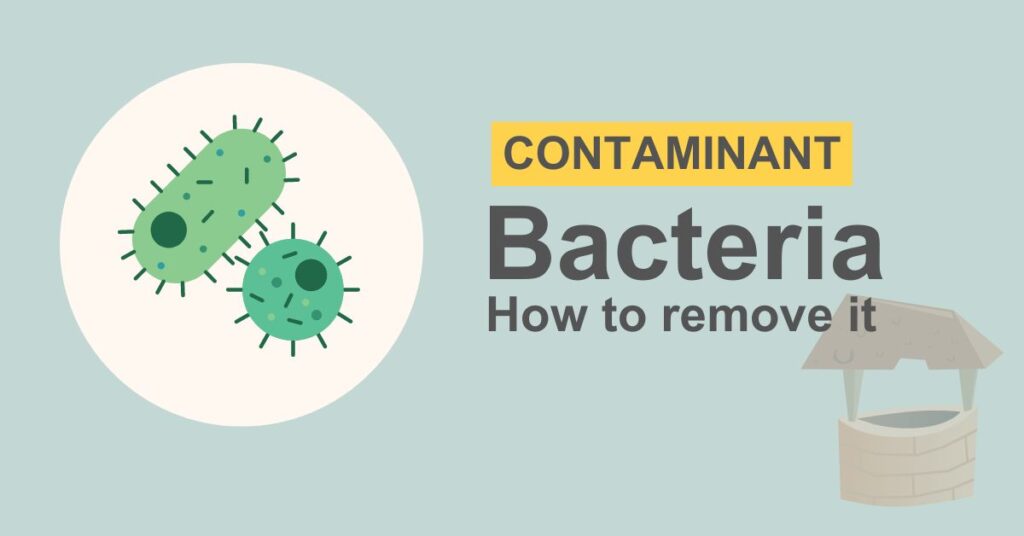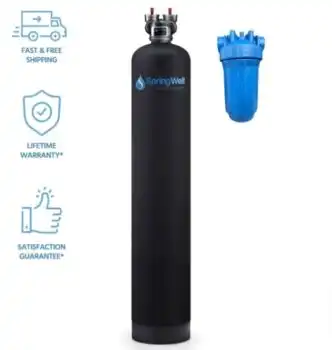Bacteria contamination in well water is pretty common. Here are 5 ways to deal with it.

Maybe you’re in the midst of a house purchase or sale, or perhaps you’re simply doing a random check on your well when you realize you have a problem on your hands – there are bacteria in your well water.
What do you do?
- Get all chlorine you can get your hands on and shock chlorinate the heck out of your water?
- Cozy up to your water filter salesman neighbor, only to be sold a $10k RO system with high maintenance costs?
- Or maybe you hang around Reddit and get wisdom from the all-wise keyboard warriors?
Truth is, the above options can work, and many times do work but they may not be the best way (or effective ways) to go about removing bacteria from your well water.
Heck, I also hang around Reddit quite a bit and love it.
In this article, we discuss the most effective and systematic ways to deal with bacteria in your well water.
How to remove bacteria in your well water
Before investing in a UV filtration system, it’s important to know that, while that might work, it may not be what you need.
If the well contamination is a once-off event, you might only need to shock chlorinate your well once the problem is fixed. However, I would still encourage you to test even so often to make sure the bacteria is gone.
Here are the practical steps I would take to troubleshoot and remove bacteria from the well:
1. Re-test the water to confirm bacteria
If you identified bacteria through at-home DIY kits, the best first thing to do would be to send your water sample to a professional lab for a confirmation test.
Reason? Coliform is pretty common in wells, but also common as a mistake during sampling (fingers, faucet, etc.). It’s not as hard to pollute the sample as many might think.
Coming back positive again? Good, now you know for sure that there is *poop* in your water.
Here is how to test bacteria in your well water.
2. Identify the source of contamination
This will not always be possible but do try to identify the source of contamination or at least develop some theory on what could be the cause.
Ask yourself:
1. Is the well properly covered, with no broken seal or casing? No dead critters in your well.
2. Has there been recent incidences of bacteria contamination in the neighborhood?
3. What about heavy rains, snow runoff, or any severe storm that may result in contamination? This might especially be the case for shallow wells.
4. Your septic tank, could it be the culprit? Maybe it’s leaking into the well?
Here is why asking these questions is important:
If the well and pipes are the source, then shock chlorination will work.
But if the problem is the supplier (groundwater) or septic tank, chances are that there will be continuous recontamination and shock chlorination will not work – this is where you might need a chlorine injection system or UV system (we’ll discuss below) if you cannot rectify at the source.
3. Shock Chlorination
Shock chlorination is cheap and can be very effective but get it wrong – not flush the system out long enough, or add insufficient chlorine quantity – you’re back to where you started.
Here are some high-level pointers to remember when shock chlorinating your well water:
1. When calculating the beach amount required, do not use the total depth of the well. Rather than use the depth of the water level, rather use the distance from the water level to the button of the well.
2. Yes you can use laundry bleach like Clorox with with 5-6% sodium hypochlorite concentration. Dilute the chlorine to avoid corroding the pipes.
3. Recirculate the water back to the well for mixing and disinfection. Once you pick up the smell, open the faucets in the house to chlorinate.
4. Once you pick up the smell in the faucets, let it sit in the pipes overnight for a good measure.
5. The following morning, run the hose outside (not in the septic tank) until the chlorine smell is gone. This will be a few hours.
6. Then after a few days, perform another test for coliform and E. coli bacteria to make sure it’s gone. You don’t have to buy an expensive lab test, a simple DIY bacteria testing kit will do the trick.
Here is an important thing to remember:
Once you’ve shock-chlorinated the water and confirmed the bacteria is gone, you need to monitor it for 3 to 6 months to confirm that you don’t have continuous contamination or recontamination. Yikes!
If you do have recontamination, then it might be worthwhile to consider the following filtration systems for bacteria treatment.
4. Continuous chlorination
Continuous chlorination is best for wells with recurrent bacterial contamination. It is done using a chemical injection system. It is installed after the water leaves the well.
Model: CIS
The chemical injection system is best for killing coliform and iron bacteria. It can also oxidize iron, sulfur, and manganese, which may also be present in well water.
The system is easy to install, plugs in a standard 110V outlet, and adds chlorine controlled by a flow sensor, resulting in consistent and optimal results. All you have to do is add bleach and water to the system periodically. The unit gives better results than ordinary chlorinators in the market because it mixes chlorine and water inside the system. It doesn’t leave pellets in the water.
- Installation videos and docs are easy to understand, if you follow the steps you should be OK.
- The whole system is mostly automated, low maintenance and involvement.
- Up to 30 GPM with minimal pressure drop.
- Comes with sediment filter to block out possible sediments form the well.
- The system is compatible with PVC, copper and Pex.
- The system is not self priming, not always. For example,when the rollers on the solution pump are retracted, its little tricky to extend them - few steps involved.
- Installation is not plug and play. If you don’t like DIY you might need a plumber’s help.
Important:
Often these systems don’t work in isolation. For example, this system might require pre-treatment to remove any possible sediments and other contaminants in the water or it might need a carbon-activated filter after the system to remove the chlorine smell if it’s a little too strong.
Read more on chlorine injection systems, how to set them up, and what other requirements you might need to know.
5. UV Purification System
Another way to deal with continuous bacteria contamination is a UV purification system. I am discussing in detail how this system works here, here I am giving you a quick rundown.
Basically, UV light affects the DNA in these micro-organisms, thus eliminating their ability to multiply or reproduce. UV purification systems are an excellent choice for removing all kinds of micro-organisms including bacteria, viruses, cysts, and other disease-causing pathogens.
Model: UVC5-15
SpringWell’s UV purification system kills up to 99.9% of bacteria, viruses, and pathogens in well water. The unit is managed by a digital control head. The UV purifier delivers 15 GPM flow rate, which is more than enough for a medium-sized family (1 - 4 bathrooms).
The electronic monitor displays the working status of the unit and when you need to replace the bulb inside the purifier. Moreover, the bulb lasts 12-18 months, depending on water quality and usage.
Similar to the chlorine injection system, it does not work in isolation. In fact, for this particular treatment system, you’ll need at least a sediment filter to stop suspended solids from clogging the UV system.
6. Whole House Filtration System
If bacteria contamination is not the only issue with your well water, then a chlorine injection system or UV system alone will not address all the contaminants in your well water.
For example, If you have a hard water problem too, you might need to add a salt-based softener system or a salt-free water conditioner (costs less on maintenance and doesn’t remove minerals from the water).
SpringWell’s whole-house well water filter removes common contaminants found in well water. It can remove iron, manganese, sulfur, or a combination of these contaminants. Or in more common language, no more orange or yellow stains in your toilet and sinks. The unit can be easily paired with SpringWell’s UV Water Purification System to kill coliform bacteria in well water.
The unit is easy to install, lasts at least 10-12 years, and doesn’t require frequent maintenance. It delivers clean, fresh, and great-tasting water.
It’s important that you get your water tested and know what’s in your water. This system will not always be necessary. You might already have some system in place but only need to deal with the bacterial problem, and in that case, adding a UV or chlorine injection system would be a better choice.
How bacteria enters well water
Most coliform bacteria will likely not cause disease but their presence could be an indication of other pathogens (e.coli, hepatitis A, legionella, etc.) that could present health risks.
How do these pathogens find their way into your well? Here are some common ways:
1. Surface contamination: Rainwater, sewage, and animal waste runoff can carry bacteria from the surface into the ground. If the well casing is cracked or seal broken, these contaminants can seep into the well water.
2. Sewage contamination: Poorly maintained septic systems, and sewage pipes can contaminate your aquifer or water source.
3. Geological contamination: Highly fractured aquifers, as well as bedrock and gravel deposits that don’t effectively filter out bacteria, can allow contaminants to reach well water.
Even simple things like a dead critter that fell into the well can cause contamination, so make sure your well is closed off and properly maintained.
Preventing future bacterial contamination
Understanding where the contamination comes from is a half-battle won.
Have you had bacterial contamination before? If not, ask a neighbor if they’ve dealt with a similar issue before? If they haven’t, that could mean, though not always, the issue is localized and comes from within your yard.
Has there recently been flooding or heavy rains? What about heavy construction work nearby?
Once you know or have a better idea of where contamination might be coming from, then fixing the problem at the source is your best bet against future contamination issues.
If contamination is from within your yard, then you have a lot more control over fixing it. Perhaps better well maintenance will do.
If it’s outside your yard, then this will probably be a little difficult to address. Unless the right authorities are involved, then your best bet will be continuous bacterial treatment systems like UV purification or chlorine injection systems.


